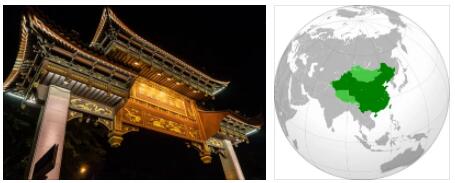Guomindang and the Communist Party
Sun Zhongshan in 1912 organized the Nationalist Party (Guomindang), but Yuan Shikai, declared illegal, brought the capital back to Beijing and began to govern autocratically. At his death (1916) the conflict between the revolutionaries and the government of Beijing worsened, which remained at the mercy of the generals who aimed to establish personal fiefdoms in the various provinces. In 1917 the government declared war on the Central Powers, while the Guomindang deputies, opposed, established a military government in Canton under Sun Zhongshan. Subsequent attempts to reunify the two governments failed, while the failure reported at the Versailles conference (failure to reintegrate the former German territories in Shandong, claimed by Japan by right of conquest) led to the outbreak of violent anti-Western student riots (1919). Alongside the students, the exponents of the new classes uprooted from the traditional Confucian order, such as the mercantile bourgeoisie and the nascent industrial proletariat, also participated in the insurrectionary movement. It was to these new forces that Sun Zhongshan turned when he reorganized the Guomindang into a mass totalitarian party with the collaboration of the Chinese Communist Party.
According to Prozipcodes, the Communist Party of China was founded in Shanghai in 1921 on the initiative of a group of Enlightenment intellectuals converted to Marxism, such as Chen Duxiu, Li Dazhao, Mao Zedong, and of Chinese trained abroad, such as Zhou Enlai. The Soviet government sent Comintern emissaries to Canton to help organize not only the Chinese Communist Party but Guomindang himself on a common basis of anti-imperialist struggle. Sun Zhongshan then proceeded to a redefinition of his ideology of the Three People’s Principles (Sanmin zhuyi), and reorganized the Guomindang on the Leninist model.
Sun’s death (1925) was followed by violent anti-imperialist upheavals, culminating in the May 30th Movement in Shanghai, which increased the already strong influence of the Communists within the Guomindang. However, the leadership of the Guomindang was assumed by the conservative general Jiang Jieshi, which in April 1927 broke with the Communist Party, massacring its cadres gathered in Shanghai. Meanwhile he completed the campaigns against the Northern warlords, unifying at least formally China under the government of Guomindang, whose headquarters had been established in Nanjing. With the warlords liquidated, Jiang turned against the Communists, who had proclaimed a Soviet Republic of China in 1931, with its capital in Ruijin, Jiangxi. He managed to defeat the opposing army, but more than half of it escaped the encirclement and broke off with an epic march (the so-called long march), which brought the 30,000 survivors to the Northern China In Shaanxi the communists organized an autonomous Soviet administration and Mao Zedong was recognized as the undisputed leader of the communist movement in China. Meanwhile the nationalist regime, whose power was held by a narrow political oligarchy dominated by Jiang Jieshi, was failing in economic policy, in the program of ‘rural reconstruction’ and in attempts to promote industrial development and credit modernization. The Japanese aggression contributed decisively to Jiang’s difficulties.
The civil war
The Japanese occupied Manchuria in 1931, erecting it as a separate state, the Manchukuo, formally independent, actually under their control, and in 1937 they spread to Northern China In this emergency the Communists and Guomindang were forced to collaborate. The Communist Armed Forces, while maintaining their unity, were placed under the command of Jiang Jieshi. Japan’s entry into World War II reduced the Japanese military effort in China and allowed the Chinese, supplied by the allies, to hold out until the Japanese surrender (1945). The Soviet occupation of Manchuria provoked new armed clashes between nationalists and communists; the US peacekeeping missions failed and the civil war began which lasted until 1949. The Communists extended their control over Manchuria and all of northern China, in 1949 they conquered the rest of the country and on 1 October Mao proclaimed the People’s Republic of China in Beijing. The nationalist government, having taken refuge in Taiwan, was able to maintain control of the island thanks to US support.
